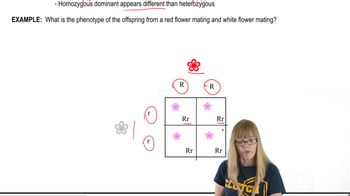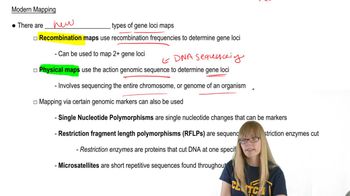Table of contents
- 1. Introduction to Genetics51m
- 2. Mendel's Laws of Inheritance3h 37m
- 3. Extensions to Mendelian Inheritance2h 41m
- 4. Genetic Mapping and Linkage2h 28m
- 5. Genetics of Bacteria and Viruses1h 21m
- 6. Chromosomal Variation1h 48m
- 7. DNA and Chromosome Structure56m
- 8. DNA Replication1h 10m
- 9. Mitosis and Meiosis1h 34m
- 10. Transcription1h 0m
- 11. Translation58m
- 12. Gene Regulation in Prokaryotes1h 19m
- 13. Gene Regulation in Eukaryotes44m
- 14. Genetic Control of Development44m
- 15. Genomes and Genomics1h 50m
- 16. Transposable Elements47m
- 17. Mutation, Repair, and Recombination1h 6m
- 18. Molecular Genetic Tools19m
- 19. Cancer Genetics29m
- 20. Quantitative Genetics1h 26m
- 21. Population Genetics50m
- 22. Evolutionary Genetics29m
4. Genetic Mapping and Linkage
Mapping Genes
Problem 28c
Textbook Question
Neurofibromatosis 1 (NF1) is an autosomal dominant disorder inherited on human chromosome 17. Part of the analysis mapping the NF1 gene to chromosome 17 came from genetic linkage studies testing segregation of NF1 and DNA genetic markers on various chromosomes. A DNA marker with two alleles, designated 1 and 2, is linked to NF1. The pedigree below shows segregation of NF1 (darkened symbols) and gives genotypes for the DNA marker for each family member.
Determine the alleles for the NF1 gene and the DNA marker gene on each chromosome carried by the four family members in generation I and generation II. Use N for the dominant NF1 allele and n for the recessive allele and assume I-1 is heterozygous for the disease allele (Nn). <>
 Verified step by step guidance
Verified step by step guidance1
Step 1: Understand the inheritance pattern of Neurofibromatosis 1 (NF1), which is an autosomal dominant disorder. This means that only one copy of the dominant allele (N) is needed for an individual to express the disorder.
Step 2: Analyze the pedigree provided. Identify the affected individuals (darkened symbols) and note their genotypes for the NF1 gene. Since the disorder is dominant, affected individuals must have at least one N allele.
Step 3: Examine the DNA marker alleles (1 and 2) for each family member. Determine which alleles are linked to the NF1 gene by observing the co-segregation of the marker alleles with the NF1 phenotype in the pedigree.
Step 4: Assign the alleles for the NF1 gene (N or n) and the DNA marker (1 or 2) to each chromosome for the family members in generation I. Use the information that I-1 is heterozygous (Nn) to help deduce the linkage.
Step 5: Extend the analysis to generation II. Use the genotypes and phenotypes of the offspring to confirm the linkage between the NF1 gene and the DNA marker alleles, ensuring consistency with the inheritance pattern observed in generation I.
Recommended similar problem, with video answer:
 Verified Solution
Verified SolutionThis video solution was recommended by our tutors as helpful for the problem above
Video duration:
6mPlay a video:
Was this helpful?
Key Concepts
Here are the essential concepts you must grasp in order to answer the question correctly.
Autosomal Dominant Inheritance
Autosomal dominant inheritance refers to a pattern where only one copy of a dominant allele is needed for an individual to express a trait or disorder. In the case of Neurofibromatosis 1 (NF1), the presence of the dominant allele (N) results in the manifestation of the disorder, regardless of the second allele's type. This means that an affected individual has a 50% chance of passing the disorder to their offspring.
Recommended video:
Guided course

Variations on Dominance
Genetic Linkage and Markers
Genetic linkage involves the tendency of genes located close to each other on a chromosome to be inherited together during meiosis. DNA markers, which are specific sequences of DNA with known locations, can be used to track the inheritance of traits. In this context, the DNA marker with alleles 1 and 2 is linked to the NF1 gene, allowing researchers to analyze the segregation patterns in family pedigrees.
Recommended video:
Guided course

Mapping with Markers
Pedigree Analysis
Pedigree analysis is a method used to study the inheritance patterns of traits within families. It involves creating a family tree that illustrates the relationships and genetic traits of family members across generations. By examining the pedigree for NF1, one can determine the genotypes of individuals based on the presence or absence of the disorder and the associated DNA markers, aiding in understanding the inheritance of the condition.
Recommended video:
Guided course

Pedigree Flowchart
Related Videos
Related Practice





